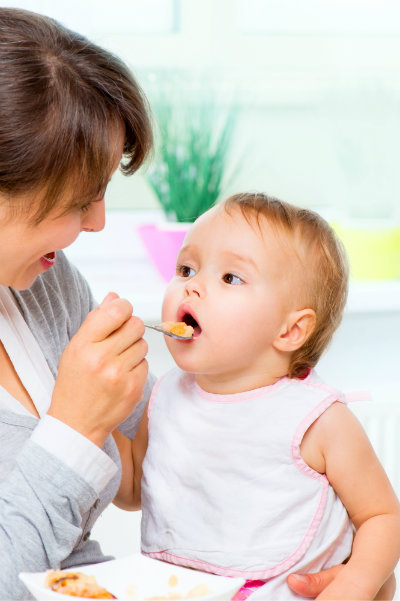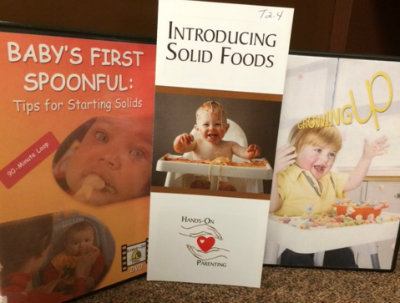 Giving your baby his first solid food is an exciting milestone. Get out the camera, the paper towels, and prepare for a new adventure! Read on to make sure you and your baby are both ready for this.
Giving your baby his first solid food is an exciting milestone. Get out the camera, the paper towels, and prepare for a new adventure! Read on to make sure you and your baby are both ready for this.
When is my baby ready for solid foods?
While breast milk is plenty of nutrition for a baby through his sixth month, about that time you may begin to see signs at that time that your child is ready to add new foods to his diet.
At six months of age, your baby may be ready to begin trying solid foods if:
- He can sit up without much support
- He can turn his head well, enough to accept or refuse food
- He shows interest in your eating, reaching for your plate, opening his mouth like you do
- Breastfeeding leaves him dissatisfied
- He has lost the infant tongue-thrusting reflex, so he won’t automatically push food out of his mouth
Don’t rush into starting solids. Your baby needs time to develop his immature digestive system and to learn more mouth control. Read this excellent article to learn the risks of starting solids too soon.
What about breastfeeding?
These new foods are meant to complement, not replace, breast milk or formula at this stage. You are just introducing solid foods, not forcing him to eat three square meals a day. Yes, that time will come, but it’s months away.
Some mothers nurse their baby before offering solid food; their babies seem willing to experiment with new food once they are no longer ravenously hungry. Others breastfeed after offering solid foods, observing their babies eat new foods better while hungriest.
Let your baby show you what works best for him.
Just don’t put baby cereal in a bottle. Babies know how to suck from a bottle; they are not able to safely “chew” cereal while sucking. This article explains more.
What else do I need to know?
Think of three S’s: Small, Single, and Slow.
Small helpings
About ¼ of a teaspoon is plenty at first. Pediatrician Dr. Sears recommends using your finger as your child’s first spoon: “It’s soft, at the right temperature, and baby is familiar with it.”
As your child becomes used to a food’s new texture and decides if he likes it, you can progress to using a soft, rounded spoon to give him a few teaspoons in one sitting. (See this chart for suggested serving sizes.)
Single ingredient
Opinions vary about which foods to feed your baby first. But everyone agrees on this: Only feed him one new food at a time. Wait as long as a week before trying another new food. This way, if something causes digestive problems or allergic reactions, you’ll know exactly which food is the culprit.
Slow and patient feeding
Remember your baby is learning a lot all at once: how to eat sitting up, how to move the food around in his mouth, whether he likes this flavor, and how to get food off a spoon. If he doesn’t really get into solid food right away, wait a while and try again later.
Help him deal with all the newness by starting a mealtime routine. Turn off the TV or loud music, wash his hands, and sit him down in a highchair to eat. Such a routine “will help your baby become conscious of eating and learn to recognize when he’s full,” says Marilyn Tanner, a registered dietician with the American Dietetic Association, quoted here.
Which foods should I start with?
Because breast-fed babies begin to use up their iron reserves around six months, many doctors recommend starting a baby on iron-fortified baby cereals. Rice is unlikely to cause an allergic reaction, so rice cereal is a safe first food.
Next foods may include things like bananas or avocados. These are rich in nutrients and easy to digest. Check this site for lists of good first foods.
Which foods should I avoid?
As your baby’s digestive system develops in his first year, avoid foods known to cause allergies, such as these:
- Cow’s milk
- Eggs
- Wheat and corn
- Chocolate
- Fresh strawberries
- Peanuts and peanut products
- Tree nuts
- Shellfish
- Citrus fruits and their juices
What dangers should I beware of for my early eater?
- Honey (It can contain deadly bacteria that cause botulism.)
- Choking hazards: popcorn, hotdogs, hard candy, raw carrots or apples, unpeeled and whole grapes, unripe pears, stringy foods, meat chunks
- Stay with your child—and put down your phone—while he’s eating. He can slip into a dangerous position in his highchair, choke on food, or inhale food very suddenly.
Introducing solid foods is a process. It leads to that exciting time when you and your child begin eating the same things, each of you feeding yourself! Now that you’ve got these pointers in mind, go on and give it a try—when Baby’s ready. And snap a few pictures of those funny, messy smiles!
——-
Nervous about feeding your baby?
Come on in to Choices Pregnancy Center. Our free brochures and video lessons
will help you feel like a pro!
Call or text today for an appointment.
——-
For Additional Information:
Great overview with answers to frequently-asked questions: http://www.askdrsears.com/topics/feeding-eating/feeding-infants-toddlers/starting-solids/faqs-about-solid-foods/solid-food-for-baby
What typical meal sizes and times may look like: http://www.whattoexpect.com/first-year/feeding-schedule-how-tos.aspx
Ideas for easy baby food prep: http://www.webmd.com/parenting/baby/baby-food-nutrition-9/baby-food-timeline
A suggested timeline for baby’s changing diet: http://www.babycenter.com/0_your-childs-feeding-timeline_10356968.bc


